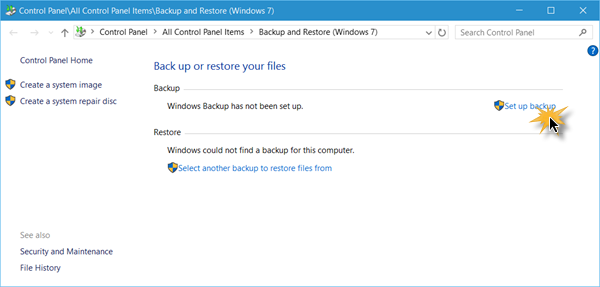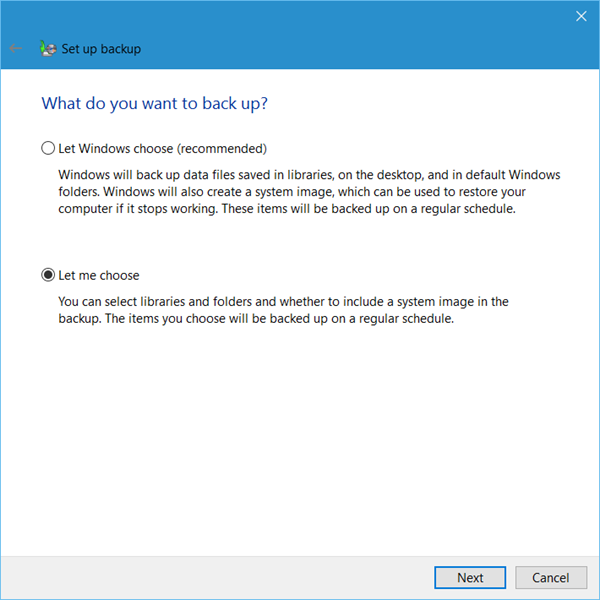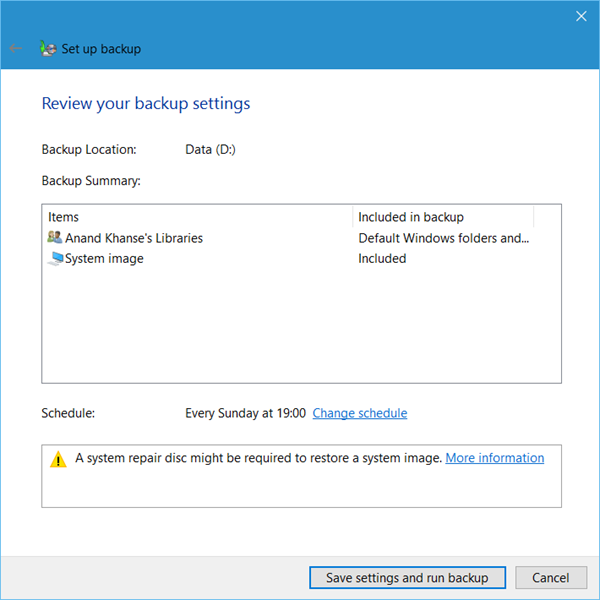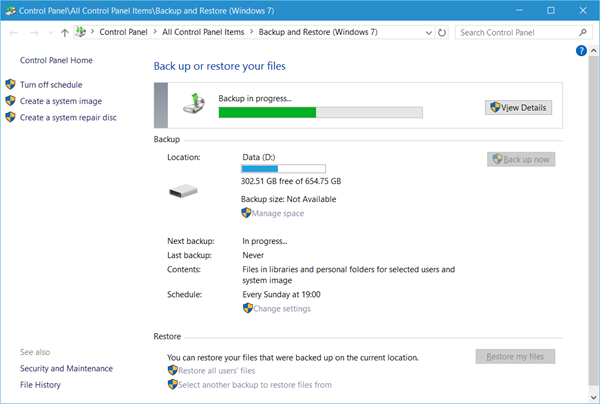Microsoft introduced a robust Backup and Restore Tool in Windows 7, that lets users create backups of their User files as well as System Images. The procedure to Backup and Restore files in Windows changed, but you can still use the Windows 7 Backup and Restore Tool in Windows 11/10. This tool also lets you create backups onto a separate drive on your computer. Let us see how to create backups of your User files as well as System Images using this tool in Windows 11/10.

Windows Backup and Restore Tool in Windows 11/10
Open the Control Panel and click open the Backup and Restore (Windows 7) applet. Click on the Set up backup link to commence.

You will be asked where you want to save your backup. You may select another drive, and an external hard drive or a network drive. In this example, I have selected my D Drive.

Clicking on Next will open up a window, where you will be asked what you would like to back up. You may select Let Windows decide, or you may select Let me choose.

Clicking on Let me choose will allow you to select the folders you want to back up and whether you want to include a System Image too. These will be backed up as per a regular schedule – which you can of course change.
Select the items you want to back up and click on Next.

Review your settings and click on the Save settings and run backup button.

The backup will commence.

The backup process is expected to take a while the first time you run it and may make your computer a bit sluggish.
Just below the Backup settings, you will see a Restore section. Using this, you will be able to restore your files. You may restore all user’s files, or you may select another backup to restore files from.
Must read: How to use Windows Backup app in Windows 11
This post will help you if Windows Backup is not working or failed.
See this post if you feel the need to free up disk space by deleting previous System Images and Backups.
How to Backup & Restore files using File History may also interest you.
Related reads:
I used Win 10 — and attempted to create a system image. Here’s what happened:
1. Click Create System Image – Windows advised not to create image in C drive — but to either DVD or external USB drive instead. OK.
2. Chose USB external drive. Windows had no objection — and completed image creation.
3. As a test — I booted up using Win 10 rescue disk and selected “restore”.
Sadly, the only choices are to (1) restore from CD/DVD drive (which my laptop doesn’t have) — or (2) from a network drive (which I also don’t have)!!
Isn’t it sad and idiotic for Windows to permit creation of image on an external USB drive — and then neglect to provide any way to point there when restoring?? ANOTHER MICROSOFT FAIL!!
You didn’t get much love from Anand, Ras.
I’m getting much the same result, although I can’t create the first backup to a DL DVD (or more, if it wishes).
Fails.
Anand, you with us?
Hi everybody!
Just to start I have to say that I’m a
deprived widower of Rescue & Recovery, the wonderful former IBM (then until Windows 7, Lenovo) program that
saved me a lot of times with its incremental backup/restore functions.
Now, in Windows 10 that program is no more supported, and I asked many
time for a valid substitute. Microsoft and also Lenovo, answered that the need
of R&R is completely overcome by the standard Windows 10 Backup and restore
functions.
Thus I used the standard functions making regularly both system images
and file backups.
Then all OK?
Unfortunately not!
The first time I needed a restore because of a Hard Drive Crash, I
started the image restore with the last copy available. The re-imaging started
perfectly and I started breathing regularly, while the restore went up for
about one hour and a half.
But
unfortunately I discovered at the end of the restore that it was unsuccessful
due to an incorrect parameter; error 0x80070057; no other comment from the
procedure.
There are many advices on the InterNet, quite common among the users,
none of them worked. Luckily informatics is my job and after a week I solved,
but a “normal” user?
Now a backup/restore like that is as a parachute full of holes, or a
lifebuoy made of lead. Horrid!
I’ll look for something better, like Acronis AOMEI or something else,
but Microsoft can be charged for refunds, being responsible of such a
disgusting functionality.
Waiting anxiously for some answer and advice…
Yours
Dr. Ing. Alberto Maria Marchetti